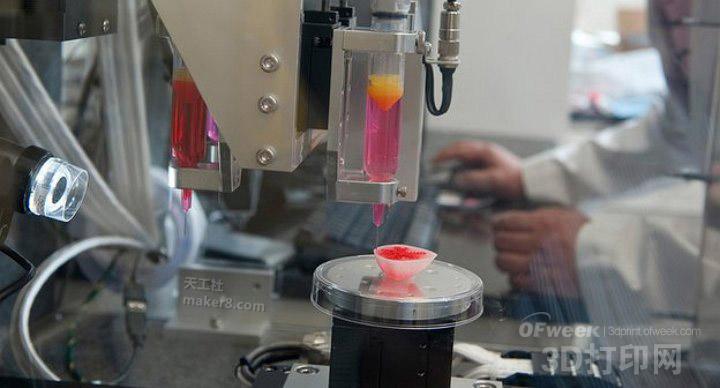American scientists have developed a 3D printer that can print large-sized "live" tissue. These tissues can survive for a long time after being transplanted into mice, and gradually "integrate" into the surrounding tissues. This new breakthrough has brought scientists closer to 3D to print real tissues and even organs and use them for clinical treatment.
In 1986, American Charles Hull invented 3D printing technology. In the following 30 years, especially since the beginning of the 21st century, with the advancement of materials science, computer technology and many other fields, 3D printing technology has made great progress. Nowadays, you can download a variety of 3D model files online and print a small clip for yourself using a 3D printer. But the application of 3D printing technology is far more limited to adding a touch of color to people's lives: designers can use 3D printers to print out the models of their own designs, so that customers have a more intuitive experience; in industrial production, there are More and more parts are being produced using 3D printing technology. For example, Airbus has claimed that its A350XWB aircraft has more than 1,000 parts produced using 3D printing technology; scientists and doctors can use According to the patient's physical characteristics, the 3D printer prints various types of implants at a "custom grade" to perform transplant surgery for the patient.

In terms of 3D printing technology, American scientists have recently made new breakthroughs in the field of biomedicine. In a paper published online in Nature Biotechnology on February 15th, scientists at the WakeForestUniversity Institute of Regenerative Medicine reported on a 3D bioprinter they developed. . Using this "Integrated Tissue-Organ Printer", the researchers successfully printed large-sized "live" tissue, including an outer ear-shaped cartilage, mandible, skull, and muscle tissue. After transplanting these tissues into mice, these tissues survived for a long time and gradually "integrated" into the surrounding tissues. This new breakthrough has brought scientists closer to printing tissue and even organs in 3D and using it for clinical treatment.
Bioprinting dilemma
The principle of the 3D bio-printer is the same as that of the conventional 3D printer. It also prints the "ink" layer by layer according to the pre-designed printing program, and finally gets the object to be printed. The difference with conventional 3D printers is on "ink": the "ink" of 3D bioprinters is usually a variety of biomaterials or biocompatible synthetic materials. Depending on the purpose of the print, live cells are sometimes included in these materials when printed. These biological or synthetic materials function to provide a degree of protection to the cells and promote their growth. Other materials play the role of "skeleton", "supporting" the printed tissue to prevent it from "collapse." Because printing needs to ensure that the biological activity of these biological materials and cells is not destroyed, 3D bio-printers are more demanding on printing conditions (such as printing temperature can not be too high, printing time should be as short as possible, etc.).

"Integrated Tissue-Organic Printers" is not the first 3D bioprinter developed by researchers. Scientists have long been working to print out tissues and even organs using biomaterials and cells as "ink." If you can print out tissues or organs, scientists can not only use them to study various diseases, but also use them to detect the efficacy and side effects of newly developed drugs, and even transplant these tissues and organs to patients. In the body, alleviate the suffering of the patient and save the patient's life.
We're professional Monopolar Forceps manufacturers and suppliers in China, specialized in providing high quality medical instruments with reasonable price. We warmly welcome you to buy or wholesale bulk forceps for sale here and get quotation from our factory.
Monopolar Forceps,Laparoscopic Forceps,Laparoscopic Grasping Forceps,Laparoscopic Dissecting Forceps
Tonglu WANHE Medical Instrument Co., Ltd , https://www.tlvanhurhealth.com
